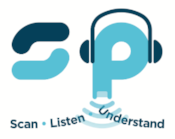Strategies For The Primary Child
STRATEGIES TO USE WITH THE PRIMARY AGED STUDENT AND THE C-PEN READER PEN
Children who experience reading difficulties will be introduced to a range of strategies and evidenced based programmes to help them overcome the issues they are facing when learning to read. Their difficulties may include dyslexia, cognitive issues and hearing loss.
The C-Pen Reader Pen is another supportive strategy which has been shown to help the student with dyslexia. Therefore, to ensure you get the best use of the pen within the classroom environment we have put together a step-by-step guide to support the individual learning needs of your students.
1. How to hold the pen: It can be incredibly frustrating for the student who finds it difficult to hold the pen and they will often state ‘it isn’t working’. Getting to grips with the pen and feeling comfortable is a positive step forward:
· Place your index finger along the top of the pen, resting comfortably, place your thumb along the bottom of the pen, the rest of your fingers should fall comfortably behind the pen. Wave it around, got a good grip? Excellent, not too tight and if too loose it will fly across the room (not a good idea).
· Now pop the front of the pen onto your paper or page, did a light come on? Excellent because that is what needs to stay on! Practice putting the light on and off!
· You will notice a ‘window’ which if you move your head lower to the page you can see the words through. You need to line that window up with the words, have a go, keep the pen on the page, the light lets you know you are doing it, and flow across the page. How did that feel?
This may take time for some students, but perseverance is worth the time and effort as soon you will have a student who is showing independence!
2. The printed word. The type of text the student is wishing to be supported with reading is quite important at primary age. Therefore, if your student requires larger gaps between each line then continue to do this, if they need a larger font, you can print up to 22 and that should work fine. Contrasting text on coloured paper does work, but it must be a good contrast, black on green, blue, yellow should work well.
3. When to use the reading pen? The following strategies have proven to be a good basis for primary aged students of when to use the pen and how to use it alongside the other strategies that work for them, such as sounding out, sight recognition and overlays.
a. Ask the student to look at the line of text and see if they recognise or know any of the words.
b. Perhaps there are words they would like to sound out, if this works for the child’s way of learning encourage them to keep doing this.
c. Do they use an overlay, now is the time to pop that on and see how the line of text looks to them.
d. If they have identified a word they are struggling with and their other strategies are not working, then use the C-Pen Reader to read that word.
e. Now ask the student to try to read the sentence for themselves, once they feel okay with this then use the C-Pen Reader to validate what they believe the sentence to be.
Validation is one of the most important aspects and requirement for the dyslexic child, this is often what prevents the child from moving on to the next piece of work, wanting to make sure they have got it right. Time can prevent the teacher and/or teacher assistant getting to the student to enable them to keep up with their peers. The C-Pen Reader will validate, will allow the child to feel proud of their achievements, will give them confidence and the independence to keep going.
4. Using the C-Pen Reader in a productive and encouraging environment will alleviate concerns raised by some that the C-Pen Reader will prevent a student to learn to read. Consideration as to why a student cannot read is always worth remember, why are they unable to process these words and what consequences this can lead to? One such coping mechanism is to step back from learning; after all there is only so many times you can get something wrong. Think of this from your own perspective, how many times are you willing to keep going before you think it’s time to let it go, you are often not surrounded by 29+ peers to judge you. Enabling the student to have confirmation what they think they have got right to be confirmed is very powerful! Equally getting it wrong, but not having this broadcast to everyone nearby, is perhaps less intimidating as the C-Pen Reader comes with headphones!
Good luck with these strategies and implement on a daily basis, eventually you will find you are watching from a distance an independent learner!
x
